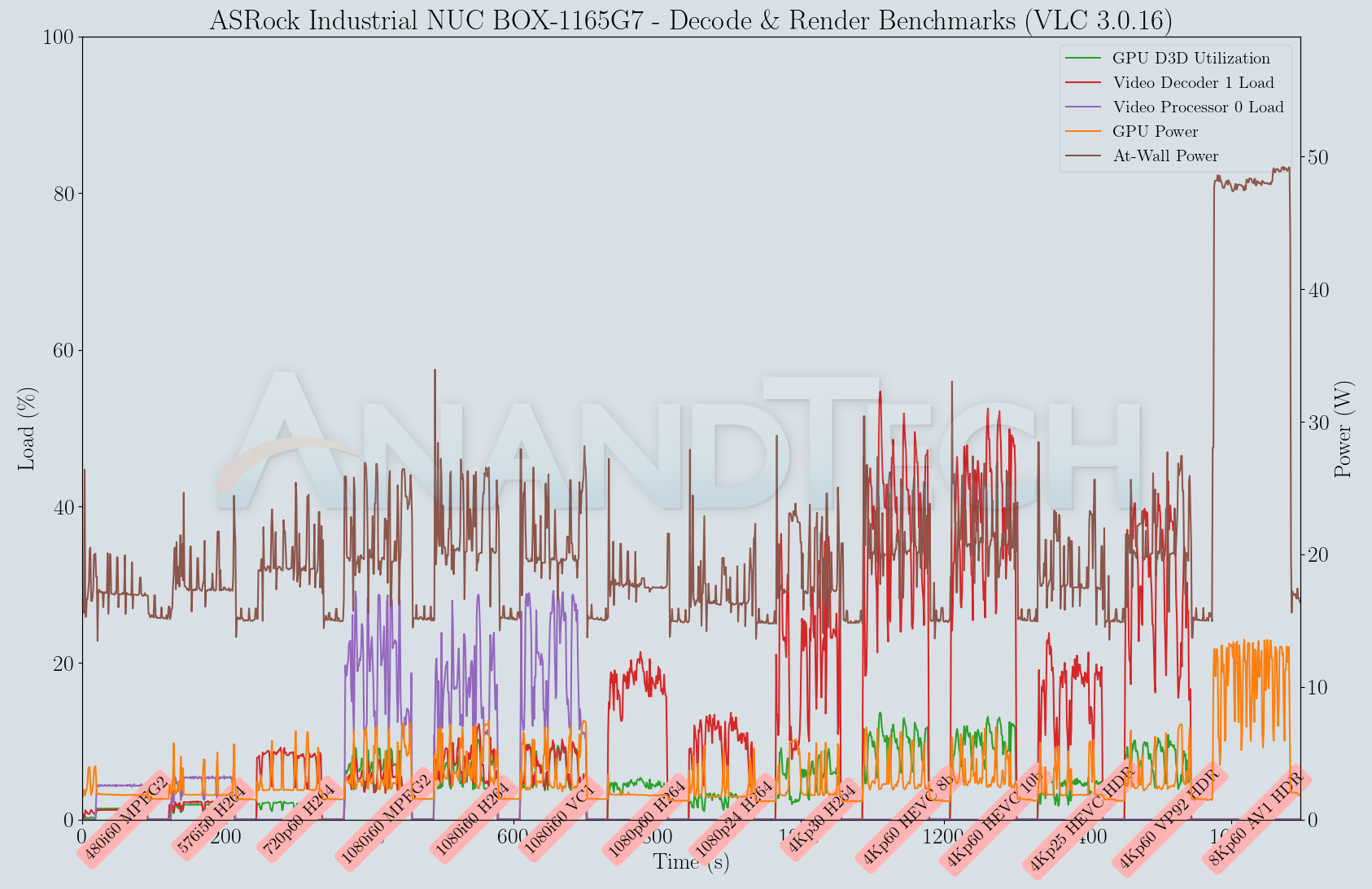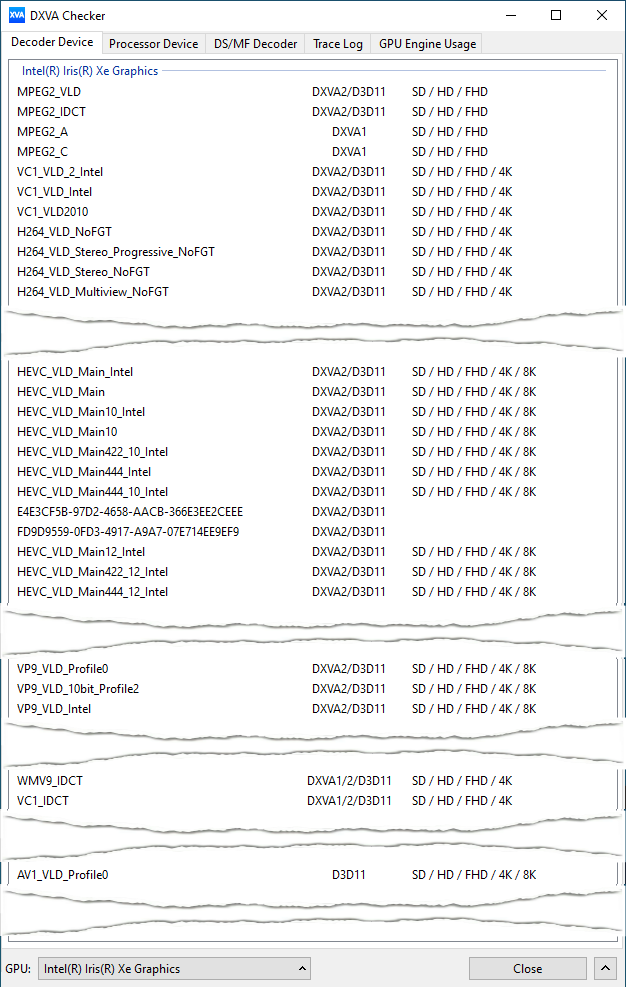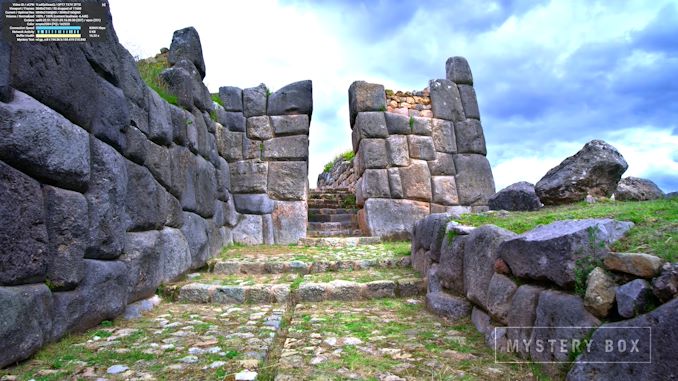ASRock Industrial NUC BOX-1165G7 Mini-PC Review: An Ultra-Compact Tiger Lake Desktop
by Ganesh T S on August 26, 2021 8:15 AM EST- Posted in
- Systems
- Intel
- NUC
- UCFF
- Willow Cove
- ASRock Industrial
- Tiger Lake-U
HTPC Workloads
Media playback and video post-processing without taxing the CPU are some of the functionalities that have been relegated to GPUs over the 10 - 15 years. The transitions to higher video resolutions and complicated video codecs have become more frequent. While the move from SD (480p) to HD (720p) took the better part of the 2000s, the transition to FHD (1080p), 4K (2160p), and now 8K (4320p) have all happened in the last decade. The rise of over-the-top (OTT) delivery platforms like YouTube, Netflix, etc. have accelerated the development and deployment of new codecs and higher resolution videos.
On Windows, GPUs expose their video decoding and post-processing capabilities via DXVA / D3D11 APIs. The DXVAChecker program provides a quick overview of the GPU features related to these aspects. All major modern codecs (including AV1) are supported for decoding across multiple resolutions. Support for decoding 4:2:2 and 4:4:4 videos is unique to Intel's hardware decoder, though it is unlikely for the NUC BOX-1165G7 to be used for processing such streams.
Windows has adopted an on-demand delivery of OS components for activating the usage of these APIs. Similar to the MS Store HEVC codec, the AV1 codec is also being delivered via the MS store. While open-source programs like MPC-HC can use the AV1 decoding capabilities of the GPU using the LAV Filters component, AV1 decoding with MS Edge requires the installation of the extension.
YouTube Streaming
The move to 4K and 8K, and the need to evaluate HDR support have made us choose Mystery Box's Peru 8K HDR 60FPS video as our test sample moving forward. On PCs running Windows, it is recommended that HDR streaming videos be viewed using the Microsoft Edge browser after putting the desktop in HDR mode.
Without installing the AV1 extension, the VP9 Profile 2 4K version is played back as shown above. However, installing the extension allows flawless playback of the 8K version, as shown in the screenshot below.
Various metrics of interest such as GPU usage and at-wall power consumption were recorded for the first four minutes of the playback of the above video in both modes (VP9 Profile 2, and AV1). The numbers are graphed below.
| YouTube Streaming Efficiency - 4Kp60 VP9.2 and 8Kp60 AV1 | |||

The playback of the 4K stream is flawless. The 8K stream, despite saturating the decoder for most of the time, did manage to play back without dropped frames except when the overlay was activated. The playback is not particularly power efficient, with the 4K stream consuming around 25W at the wall, and the 8K decode / 4K display consuming around 38W.
Evaluation of local media playback and video processing is done by playing back files encompassing a range of relevant codecs, containers, resolutions, and frame rates. A note of the efficiency is also made by tracking GPU usage and power consumption of the system at the wall. Users have their own preference for the playback software / decoder / renderer, and our aim is to have numbers representative of commonly encountered scenarios. Towards this, we played back the test streams using the following combinations:
- MPC-HC x64 1.9.14 + LAV Video Decoder (DXVA2 Native) + Enhanced Video Renderer - Custom Presenter (EVR-CP)
- MPC-HC x64 1.9.14 + LAV Video Decoder (D3D11) + madVR 0.92.17 (DXVA-Focused)
- VLC 3.0.16
- Kodi 19.1
Fourteen test streams comprising of various codecs and frame rates (each of 90s duration) were played back from the local disk with an interval of 30 seconds in-between. Various metrics including GPU usage and at-wall power consumption were recorded during the course of this playback.
All our playback tests were done with the desktop HDR setting turned on. It is possible for certain system configurations to have madVR automatically turn on/off the HDR capabilities prior to the playback of a HDR video, but, we didn't take advantage of that in our testing.
VLC and Kodi
VLC is the playback software of choice for the average PC user who doesn't need a ten-foot UI. Its install-and-play simplicity has made it extremely popular. Over the years, the software has gained the ability to take advantage of various hardware acceleration options. Kodi, on the other hand, has a ten-foot UI making it the perfect open-source software for dedicated HTPCs. Support for add-ons make it very extensible and capable of customization. We played back our test files using the default VLC and Kodi configurations, and recorded the following metrics.
| Video Playback Efficiency - VLC and Kodi | |||

Both VLC and Kodi perform software decoding for the 8Kp60 AV1 stream. The Core i7-1165G7 is simply unable to keep up with the requirements, resulting in a slideshow of sorts. Other codecs present no challenge to the system, with hardware-accelerated decode ensuring power consumption remains modest at around 20 - 25 W.
MPC-HC
MPC-HC offers an easy way to test out different combinations of decoders and renderers. The first configuration we evaluated is the default post-install scenario, with only the in-built LAV Video Decoder forced to DXVA2 Native mode. One additional pass was done with madVR configured to make use of the DXVA-accelerated video processing capabilities as much as possible. The metrics collected during the playback of the test files using the above three configurations are presented below.
| Video Playback Efficiency - MPC-HC with EVR-CP and madVR | |

The LAV Filters integrated in MPC-HC 1.9.14 is able to successfully play back the 8Kp60 AV1 stream with hardware acceleration. In fact, the decoder load is much lesser compared to playing back the stream using the MS Edge browser. On the flop side, the average power consumption at the wall is a tad higher compared to playing back the same streams with Kodi. The madVR (DXVA) configuration also surprisingly played back almost all the streams without frame drops.













33 Comments
View All Comments
dullard - Friday, August 27, 2021 - link
1) "Asrock Industrial" is the name of the company.2) The thing that most defines industrial computers is the promise to keep parts and productions for longer than most other computers. If you buy a Dell home computer, it might have a randomly selected hard drive or memory that differs each time you order it. If you buy a Dell business computer, you might get the same hard drive or same memory for a couple years. Many industrial computers have the exact same parts guaranteed to be in production for often up to 7 years. That really matters when you put in a fortune into equipment and another fortune into qualification of that equipment and suddenly the computer goes down.
Fanless is nice, but certainly not the biggest industrial need.
zsdersw - Monday, August 30, 2021 - link
If it's not fanless and rugged it's not "industrial", as its components won't last as long (dust and other particulates in the air are never good for electronics). Using a computer in an industrial environment commands a level of ruggedness that you won't find in any computer fan.dullard - Monday, August 30, 2021 - link
There are plenty of industries that are not filthy.mode_13h - Tuesday, August 31, 2021 - link
Yeah, exactly. There are applications like kiosks, point-of-sale, and backroom appliances.zsdersw - Tuesday, August 31, 2021 - link
All of which benefit from fanless computers. Dust is everywhere and always bad for electronics.dullard - Tuesday, August 31, 2021 - link
Dust can also collect on fins on fanless computers and render their cooling worse. It isn't a concept of "works" vs "doesn't work".zsdersw - Wednesday, September 1, 2021 - link
It can, but with nothing to draw dust inside the computer it doesn't happen to a noticeable degree over the time between when the computer is deployed and when it's obsolete.mode_13h - Tuesday, September 21, 2021 - link
> with nothing to draw dust inside the computer it doesn't happen to a noticeable degree> over the time between when the computer is deployed and when it's obsolete.
That's not necessarily true. It depends on how prone the enclosure is to collecting dust, the orientation in which it's mounted, how much dust is in the environment where it's used, and how long it remains in service. It's not uncommon for machines to have a service life of close to a decade.
Yes, we can agree that fanless is the better option, if you're at all worried about dust. Whoever wants this SFF "industrial" PC must care more about size and performance than maintenance costs.
Manvadher - Friday, August 27, 2021 - link
I really love this site and its reviews but why did you do this"The NUC-1165G7 places the 4.09" x 4.02" motherboard inside a chassis measuring 110 mm x 117.5 mm x 47.85 mm"
Two different units in the same sentence!
Either way thank you for the review!
ganeshts - Monday, August 30, 2021 - link
The 4x4 and 5x5 are recognized stand-ins for the NUC and mini-STX form-factors respectively, and I was using the imperial measurements to convey that this is a standard NUC board. I have since edited the piece to add the SI measurements also for the motherboard dimensions.